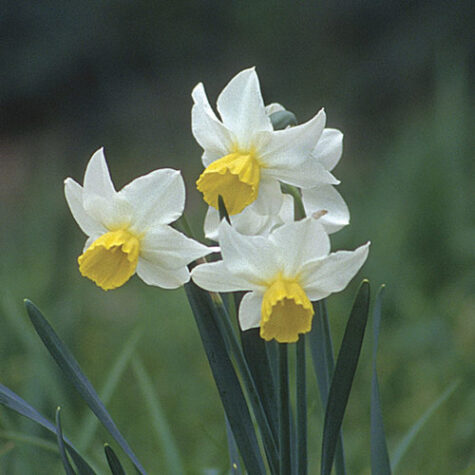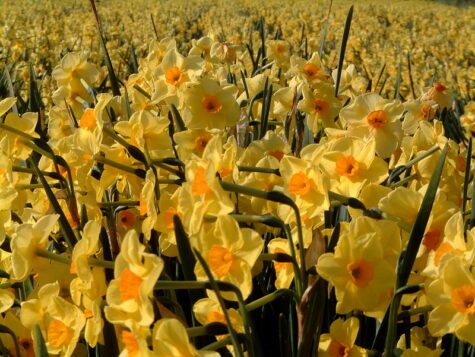March Lore
Those born in the month of March have the honor of calling the daffodil and the jonquil their birth flowers. Although the plants are from the same family, and are thus very similar, you can tell the difference between them by examining the leaves. Daffodils sport slim, sword-tipped foliage and jonquils have slender leaves with rounded tips.
Daffodils and Jonquils are suitable altar decorations for any rituals celebrating the coming of spring and suitable offerings for solar deities, water and nature spirits, especially those identified as female. It should be noted that daffodils are toxic, especially the bulbs and can cause irritation to the skin and so should be used with appropriate caution.
- Sprinkle dried petals or place fresh flowers on an altar to attract friendly spirits.
- Keep in the house or garden to cheer you up.
- Wear a daffodil in your breast pocket for luck and to have a cheerful mood follow you all day.
- Add to bathwater to increase your luck and bring new people into your life.
- A bouquet of daffodils in the bedroom may increase fertility.
- Mix with rose petals and place around a photo of a lover you want to return to you.
- Keep freshly cut daffodils in a vase in your home to bring about abundance.
- Place daffodils on your altar during workings related to love, especially if it’s a new relationship and you’re still trying to figure out how to navigate the waters.
- Add potted daffodil bulbs, don’t worry if they’re blooming yet, to your altar for spring celebrations, along with other spring flowers such as forsythia, crocus, and snowdrops.
- Wear this flower close to your heart to draw love, but be careful that your love is not one-sided.
Daffodil
The daffodil is the March birth flower and the meaning it holds is friendship and domestic happiness.
The daffodil symbolizes new beginnings, rebirth, and the arrival of spring thanks to it being one of the first perennials to blossom after the winter frost. And, along with creativity and renewal, it has also come to represent forgiveness, inspiration, and memory. Daffodils are also representative of inner reflection and an awareness of oneself.
Symbolizing rebirth, resurrection, renewal and new beginnings, the daffodil is virtually synonymous with spring. Though their botanic name is narcissus, daffodils are sometimes called jonquils, and in England, because of their long association with Lent, they’re known as the “Lent Lily.”
The Daffodil is a calming flower that helps bring about inner peace, hope and, of course, self-love. It may also be used in spells related to unrequited love. To dream about seeing or picking daffodils is said to symbolize happiness and adoration.
Daffodil commonly refers to narcissus with large trumpets, but may be used for all types of narcissus. This is the official common name for ANY of the plants that fall into the genus Narcissus. So, if the plant is considered a Narcissus, it is also considered a daffodil as well.
In Victorian flower language daffodils signified regard and chivalry, whilst narcissi meant self esteem, female ambition or vanity.
Jonquil
Jonquils usually have one to five flowers per stem and short coronas. Look at where they are joined to the stem. It is almost a ninety degree angle from the stem to the flower.
These sweet-scented flowers are the most fragrant of all the Narcissus and many scented hybrids trace their fragrance back to them.
Roman mythology tells us that Pluto, the god of the underworld, kidnapped Persephone, who eventually became his queen, while she was picking lilies. In her fright at the ambush, she dropped her blooms, and they became jonquils when they hit the ground.
Jonquils have many meanings, and you can use any combination of these when presenting them to someone you care about!
For the Greeks they sometimes express sorrow and sympathy, so you could use them in a bouquet for someone who’s recently suffered a loss or undergone some trauma. In China, jonquils are symbolic of luck in the New Year and, for the March baby in your life, they symbolize domestic bliss and friendship.
Sources:
According to astrological and lunar lore, there are best days for doing a variety of tasks. The best days listed here are based on both the phase of the moon and its position in the zodiac. Many people believe that if you do the tasks on the dates listed, you will get the best results possible.
March 1:
- Castrate Farm Animals
- Mow Grass (to slow growth)
- Plant Root Crops
- Potty Train a Child
- Prune Trees
- Wean a Baby or an Animal
March 2:
- Castrate Farm Animals
- Cut Hair (to slow growth)
- Dig Post Holes
- Harvest
- Kill Plant Pests
- Make Jams and Jellies
- Mow Grass (to slow growth)
- Paint
- Potty Train a Child
- Quit Smoking
- Start Diet (to lose weight)
- Wash Wooden Floors
- Wean a Baby or an Animal
March 3:
- Castrate Farm Animals
- Cut Hair (to slow growth)
- Dig Post Holes
- Harvest
- Kill Plant Pests
- Make Jams and Jellies
- Mow Grass (to slow growth)
- Paint
- Potty Train a Child
- Quit Smoking
- Start Diet (to lose weight)
- Wash Wooden Floors
- Wean a Baby or an Animal
March 4:
- Castrate Farm Animals
- Cut Hair (to slow growth)
- Dig Post Holes
- Harvest
- Kill Plant Pests
- Make Jams and Jellies
- Mow Grass (to slow growth)
- Paint
- Potty Train a Child
- Quit Smoking
- Start Diet (to lose weight)
- Wash Wooden Floors
- Wean a Baby or an Animal
March 5:
- Brew
- Can Fruits and Vegetables
- Castrate Farm Animals
- Get Married
- Mow Grass (to slow growth)
- Plant Root Crops
- Potty Train a Child
- Transplant (seedlings and plants)
- Wean a Baby or an Animal
March 6:
- Castrate Farm Animals
- Cut Firewood
- Cut Hair (to increase growth)
- Dig Holes
- Get Married
- Mow Grass (to increase growth)
- Plant Above Ground Crops
- Potty Train a Child
- Start Diet (to gain weight)
- Wax Floors
- Wean a Baby or an Animal
March 7:
- Bake
- Cut Firewood
- Dig Holes
- Kill Plant Pests
- Mow Grass (to increase growth)
March 8:
- Bake
- Cut Firewood
- Dig Holes
- Kill Plant Pests
- Mow Grass (to increase growth)
March 9:
- Bake
- Cut Firewood
- Dig Holes
- Kill Plant Pests
- Mow Grass (to increase growth)
March 10:
- Advertise Something for Sale
- Buy a Home
- Cut Firewood
- Cut Hair (to increase growth)
- Dig Holes
- Get Married
- Mow Grass (to increase growth)
- Paint
- Plant Above Ground Crops
- Wax Floors
March 11:
- Advertise Something for Sale
- Buy a Home
- Cut Firewood
- Cut Hair (to increase growth)
- Dig Holes
- Get Married
- Mow Grass (to increase growth)
- Paint
- Plant Above Ground Crops
- Wax Floors
March 12:
- Cut Firewood
- Dig Holes
- Kill Plant Pests
- Mow Grass (to increase growth)
- Travel (for pleasure)
March 13:
- Cut Firewood
- Dig Holes
- Kill Plant Pests
- Mow Grass (to increase growth)
- Travel (for pleasure)
March 14:
- Bake
- Cut Firewood
- Cut Hair (to increase growth)
- Dig Holes
- Get Married
- Mow Grass (to increase growth)
- Plant Above Ground Crops
- Plant Flowers
- Plant Seed Beds
- Start Diet (to gain weight)
- Wax Floors
March 15:
- Bake
- Cut Firewood
- Cut Hair (to increase growth)
- Dig Holes
- Get Married
- Mow Grass (to increase growth)
- Plant Above Ground Crops
- Plant Flowers
- Plant Seed Beds
- Start Diet (to gain weight)
- Wax Floors
March 16:
- Cut Firewood
- Dig Holes
- Get Married
- Kill Plant Pests
- Mow Grass (to increase growth)
- Paint
- Travel (for pleasure)
March 17:
- Cut Firewood
- Dig Holes
- Get Married
- Kill Plant Pests
- Mow Grass (to increase growth)
- Paint
- Travel (for pleasure)
March 18:
- Cut Firewood
- Dig Holes
- Kill Plant Pests
- Mow Grass (to increase growth)
- Wax Floors
March 19:
- Cut Firewood
- Dig Holes
- Kill Plant Pests
- Mow Grass (to increase growth)
- Wax Floors
March 20:
- Cut Hair (to slow growth)
- Mow Grass (to slow growth)
- Plant Flowers
- Plant Root Crops
- Slaughter
March 21:
- Cut Hair (to slow growth)
- Mow Grass (to slow growth)
- Plant Flowers
- Plant Root Crops
- Set Eggs
- Slaughter
March 22:
- Can Fruits and Vegetables
- Hunting
- Make Jams and Jellies
- Mow Grass (to slow growth)
- Plant Root Crops
- Plant Seed Beds
- Prune Trees
- Set Eggs
- Slaughter
- Transplant (seedlings and plants)
March 23:
- Can Fruits and Vegetables
- Hunting
- Make Jams and Jellies
- Mow Grass (to slow growth)
- Plant Root Crops
- Plant Seed Beds
- Prune Trees
- Set Eggs
- Transplant (seedlings and plants)
March 24:
- Can Fruits and Vegetables
- Hunting
- Make Jams and Jellies
- Mow Grass (to slow growth)
- Plant Root Crops
- Plant Seed Beds
- Prune Trees
- Transplant (seedlings and plants)
March 25:
- Advertise Something for Sale
- Castrate Farm Animals
- Cut Hair (to slow growth)
- Demolition
- Dry Fruits and Vegetables
- Kill Plant Pests
- Mow Grass (to slow growth)
- Pick Apples and Pears
- Potty Train a Child
- Quit Smoking
- Start Diet (to lose weight)
- Wash Windows
- Wash Wooden Floors
- Wean a Baby or an Animal
March 26:
- Advertise Something for Sale
- Castrate Farm Animals
- Cut Hair (to slow growth)
- Demolition
- Dry Fruits and Vegetables
- Kill Plant Pests
- Mow Grass (to slow growth)
- Pick Apples and Pears
- Potty Train a Child
- Quit Smoking
- Start Diet (to lose weight)
- Wash Windows
- Wash Wooden Floors
- Wean a Baby or an Animal
March 27:
- Castrate Farm Animals
- Mow Grass (to slow growth)
- Plant Root Crops
- Potty Train a Child
- Prune Trees
- Wean a Baby or an Animal
March 28:
- Castrate Farm Animals
- Mow Grass (to slow growth)
- Plant Root Crops
- Potty Train a Child
- Prune Trees
- Wean a Baby or an Animal
March 29:
- Castrate Farm Animals
- Cut Hair (to slow growth)
- Dig Post Holes
- Harvest
- Kill Plant Pests
- Make Jams and Jellies
- Mow Grass (to slow growth)
- Paint
- Potty Train a Child
- Quit Smoking
- Start Diet (to lose weight)
- Wash Wooden Floors
- Wean a Baby or an Animal
March 30:
- Castrate Farm Animals
- Cut Hair (to slow growth)
- Harvest
- Kill Plant Pests
- Make Jams and Jellies
- Mow Grass (to slow growth)
- Paint
- Potty Train a Child
- Quit Smoking
- Start Diet (to lose weight)
- Wash Wooden Floors
- Wean a Baby or an Animal
March 31:
- Castrate Farm Animals
- Cut Hair (to slow growth)
- Harvest
- Kill Plant Pests
- Make Jams and Jellies
- Mow Grass (to slow growth)
- Paint
- Potty Train a Child
- Quit Smoking
- Start Diet (to lose weight)
- Wash Wooden Floors
- Wean a Baby or an Animal
Source: The Farmer’s Almanac
This month was sacred to the Roman god Mars, hence the name March. Mars is similar to the Greek Ares, Tiu or Twaz of Central and Northern Europe, Teutates of the Celts, and Tyr of the Norse. The Roman goddess Bellona, goddess of war, had her special day during this month.
March is generally a blustery month weather-wise. The old weather saying “In like a lion, out like a lamb” is an apt description of March weather. For the Romans, it was the beginning of their year. The Spring Equinox, which falls around March 21 or 22, was a sacred and celebrated time in a great many world cultures. In the Southern Hemisphere, this would be equal to the Autumn Equinox, as the seasons are reversed. The Incas celebrated Pacha-puchy, or Earth Ripening, at this time.
The Roman Matronalia honored Juno Lucina, an aspect of the goddess Juno, who protected women, children and the family. Statues of the goddess were decorated with flowers, and special temple fires were lit. Girls made offerings to Juno Lucina at this time of year for happy and prosperous marriages.
The statue of Isis suckling her child symbolizes this goddess’s aspect as the Great Mother, the caretaker of the Earth and all life. Flowers were floated on the rivers and the boats blessed with incense.
In Canaan and other Semitic countries, the goddess Astarte was honored in a Spring celebration. Red eggs were given as gifts to family and friends, the beginning of our Easter egg tradition. Her sacred city of Byblos was noted for its extensive libraries before they were destroyed. As queen of heaven, Astarte wore crescent horns and was said to tirelessly create and destroy. The kings of Sidon ruled only with the goddess’s permission and called themselves the Priest of Astarte. Other cultures in the Middle East knew Astarte as Asherat of the Sea and Astart, queen of heaven.
Athene/Minerva,the armed goddess of wisdom,reigned over the biggest social event in Greece – the five day Spring competition featuring events in athletics, music, poetry and satire. Crowns of olive branches and flasks of olive oil were given to the winners of each event. On the final day, Athene’s birth was celebrated by draping the goddess’s statue in a new sacred garment.
This particular festival of Cybele, the Hilaria, was a happy time. Our word “hilarious” has similar word roots. The goddess Cybele can be compared to Demeter in many ways; Cybele represented the Earth as did Demeter and had a Spring resurrected son/lover Attis, who corresponded to Kore/Persephone. This happy festival celebrated the power of Cybele to overcome death.
Eostre was the German goddess of rebirth. Rabbits and colored eggs were fertility symbols connected with Her. Originally, Oestre was the goddess of the Spring Equinox whose name was changed to Easter by the Christians.
The Roman Luna, goddess of the Moon, was honored with the baking, exchanging, and eating of Moon cakes. Even the Chinese and Europeans knew of Moon cakes and some form of this goddess.
From: Moon Magick
Amaolikkervik Moon ~Inuit
Big Famine Moon ~Choctaw
Bud Moon ~Kiowa
Budding Trees Moon ~Medicine Wheel
Buffalo Calf Moon ~Arapaho, Sioux
Catching Fish Moon ~Agonquin
Chaste Moon ~Medieval English
Crow Moon ~Algonquin
Crane Moon ~Potawatomi
Crust Moon ~Algonquin
Deer Moon ~Natchez
Death Moon ~Neo-Pagan
Eagle Moon ~Cree
Fish Moon ~Colonial American
Green Moon ~Pima
Lenten Moon ~Cherokee
Little Frog Moon ~Omaha
Little Spring Moon ~Creek, Muscokee
Lizard Moon ~San Juan
Long Days Moon ~Wishram
Moon of Winds ~Celtic
Moose Hunter Moon ~Abenali
Much Lateness Moon ~Mohawk
Rain Moon ~Diegueno
Plow Moon ~Janic (full)
Sap Moon ~Algonquin
Seed Moon ~Janic (dark)
Snow Crust Moon ~Anishnaabe
Snow Sore Eyes Moon ~Dakota
Spring Moon ~Passamaquoddy
Strawberry ~Cherokee
Sugar Moon ~Algonquin
Whispering Wind Moon ~Hopi
Wind Strong Moon ~Taos
Windy Moon ~Cherokee
Worm Moon ~Algonquin
“You’re right to come, Marcher; your days demand their place
and the month that bears your stamp is here.”
~Ovid
March (Martius), the first month of the lunar calendar, was named after Mars and the entire month was dedicated to Him. The festivals reflected a purification and regeneration of the arms and fields, marking a time when farmers had to think of cultivating and protecting their lands. The efficacy of Mars’ divine aid was much needed in preparation for the seasonal crop growth and upcoming military campaigns, as wars often began or were renewed in the spring.
March 1st was the lunar calendar’s New Year’s Day, and may have also been Mars’ birthday. The festival of Quinquatrus (named for its length of five consecutive days) commenced on 19 March when the ancilia of the Salii and the weapons of the whole army were purified.
On 23 March, the Romans venerated Mars during the Tubilustrium, a cleansing ceremony for the trumpets used in sacred rites and the instruments of the entire army. A subsequent purification rite was performed on 19 October during the Armilustrium, and the Salii, commemorating the return of the legions in the fall, made their final procession through the streets of Rome. It signified the end of the military campaign season when arma (arms) and ancilia were purified and laid to rest for the winter.
How do we relate to Mars this month?
With Mars, there is no contemplation before action. The drive associated with Mars differs from that of the Sun in that it is self-assertion rather than assertion of the will; it is raw energy rather than creative energy.
Mars is still the essence of the god from antiquity. He is still the captivating aggressor, the rouser, and the protagonist of destiny; breathtakingly candid in His purpose and deliberate in His bounty. Mars personifies a vigorous energy that carries with it its own reproductive weight, immersed in singular ambition, and seldom outdone. He is the quintessential model of male sexuality; the catalyst for creation Who leaves little doubt that our perpetuation is imminent and our survival inevitable. Yet His artful passion is lucid; a flowing expression steeped in honorific intent and delivered with remarkably unbiased conveyance.
The expression of our basic needs remains the one true constant among all living beings. When we peel back the layers of aspirations and ideals, we reach the crux of the human race with uncanny fidelity; the instinctual drives that have served us so well. It is here, at this center that we find Mars, ceaselessly reminding us that no matter how far we venture from this place, the road back is always nearer than we realize.
How do we honor Mars this month?
Mars represents the instinctive nature still evident in all species: that of survival and protection. In antiquity, Mars’ reigning aspects were interwoven into a society that understood a definable application of pursuit and preservation. The Romans recognized the necessity of this sequence as the occurring truth behind any deliberate progress. These enduring principles are at the very heart of Perpituitas; qualities attributed to our role as the caretakers of our posterity.
In His warrior aspect we associate Mars with iron, but an iron will is of the same caliber. Protection has always been our gift to those we love, and a duty to ourselves. Though we no longer spend our days in the fields, the fruits of our labors still determine the quality of our life.
Pray to Mars when you need to shift into another gear, to bring your purpose from wishful pondering to fruition and culmination. Look to Mars when your spirit needs reawakening and you find yourself lost in the cycle of delay, needing to summon up the courage to act. When the mundane begins to chisel your determination into quiet resignation, let Mars hear your call to arms. His still powerful voice speaks volumes to all who listen. Mars continues to provoke and ignite while craftily providing us with His earthly wisdom; those universal gifts of our own nature which allow us to fully embrace our life’s experience and remain secure in our duration.
Source: Religioromana










